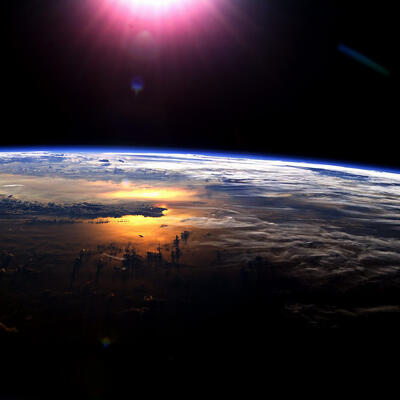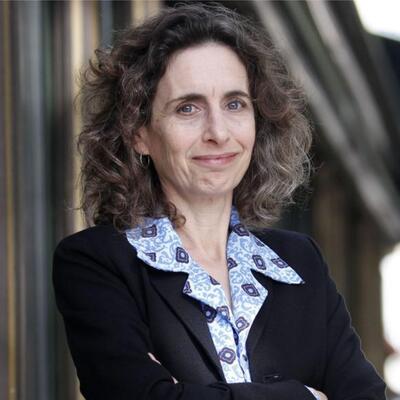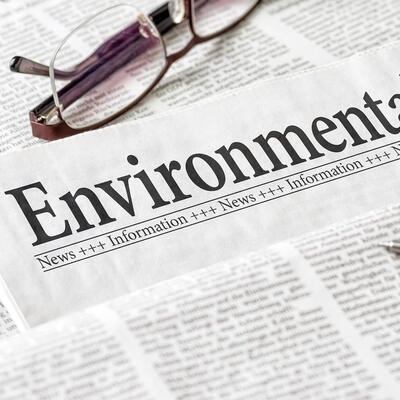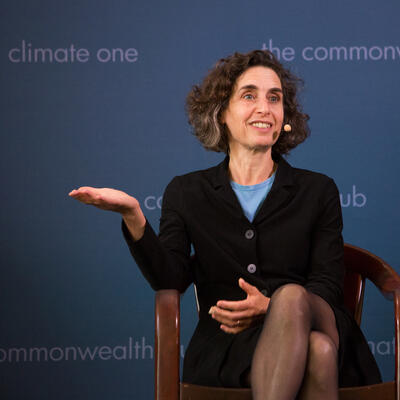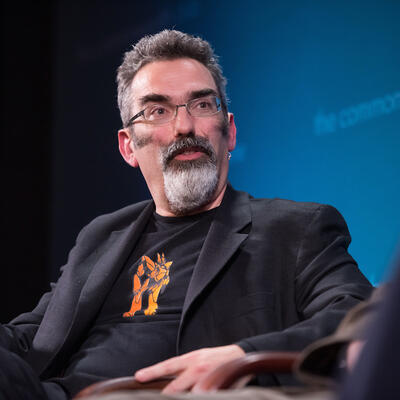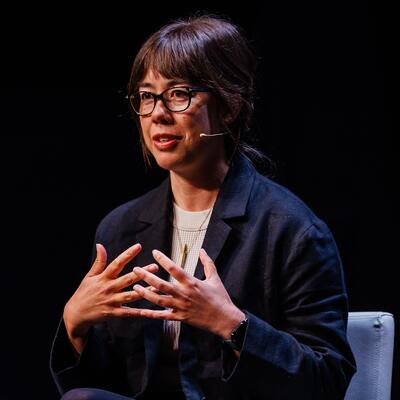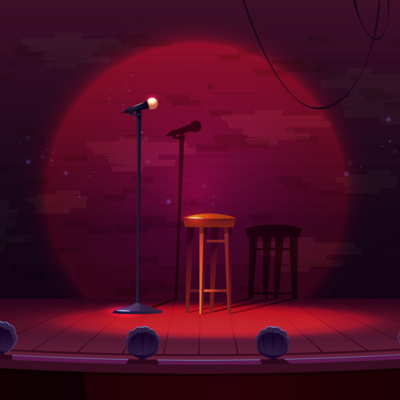
Climate Narratives with Elizabeth Kolbert, Kim Stanley Robinson and Jeff Biggers
Guests
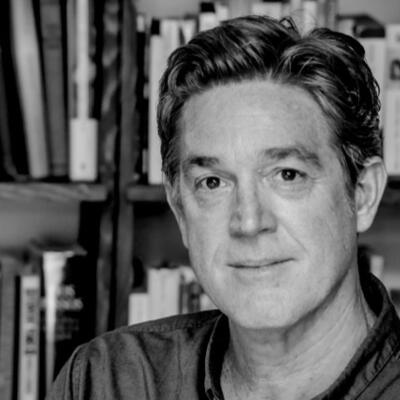
Jeff Biggers
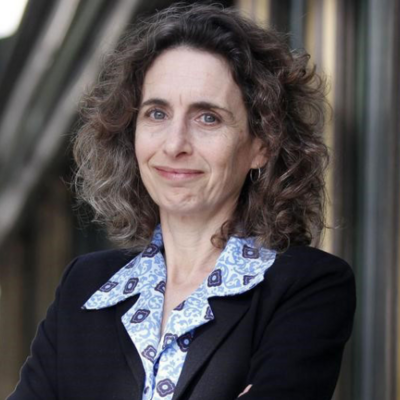
Elizabeth Kolbert
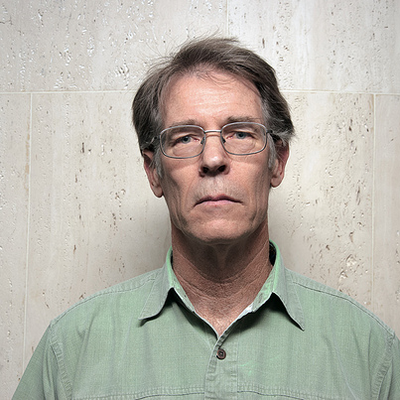
Kim Stanley Robinson
Summary
In the past decade, narratives of a dystopian climate future have helped connect people with characters in worlds decimated by industrial expansion and climate disruption. In the real world, scientists are looking to geo-engineering and other innovations to help preserve the well-being of life on Earth.
“20 years ago you were writing about this and you’re just a journalist off on a wild goose chase or you're a science fiction writer portraying an implausible future,” says acclaimed science fiction writer Kim Stanley Robinson, “Now everybody's there.”
Robinson is the author of more than twenty books, including the best-selling Mars trilogy. His most recent novel is "The Ministry for the Future," which uses fictional eyewitness accounts to tell the story of a climate future that may not be so far off.
“I conceived of it as being the most hopeful outcome for the next 30 years that you could still believe in given where we are now,” he says.
Those outcomes are also the subject of the new book from New Yorker staff writer Elizabeth Kolbert. In "Under a White Sky: The Nature of the Future," she explores how the very ways in which humans have transformed and damaged the well-being of life on Earth may also hold the keys to preserving it.
“Controlled flooding to counteract the effects of flood control,” she cites as one example, “these sorts of interventions that then demand new interventions on top of them.”
Despite being an award-winning climate writer, Kolbert still grapples with how to make something as huge as global climate disruption about human beings and their stories.
“Often I'm out with people who are trying to learn something at the edge of what's known,” she explains, “so we personalize it by going on a journey.”
Journalist and oral historian Jeff Biggers experienced a similar frustration trying to tell the story of the coal industry’s impact on his native southern Illinois. That struggle led him to create the Climate Narrative Project.
“If you approach climate narratives as cultural historians as cultural storytellers,” he says, “I think we can begin to understand that it's about the people, and it's about how those people relate to us and how we relate to them in their everyday lives.”
Biggers found that relying on data compiled in policy papers or PowerPoint presentations was failing to get vital information into the hands of the community.
“What we’re missing is a way to galvanize engagement, [to] galvanize people to support policies that are actually gonna change,” he says, “and that only can happen when we have effective climate storytelling.”
Resources From This Episode (4)
Full Transcript
Greg Dalton: This is Climate One. I’m Greg Dalton. [pause] How can storytelling help connect us with the realities of a changing climate?
Elizabeth Kolbert: Often we’re on a voyage of discovery, often I'm out with people who are trying to learn something at the edge of what's known.
Greg Dalton: As dystopian visions edge closer to reality, novelists are also finding ways to help re-imagine our climate future.
Kim Stanley Robinson: I conceived of it as being the most hopeful outcome for the next 30 years that you could still believe in.
Greg Dalton: Do we need a new climate narrative — a road map for understanding and tackling the climate emergency?
Jeff Biggers: How do we find creative ways using the narrative arts to tell the story in a way that allows us to re-root ourselves back in our communities and also allows us to see the experience of other people.
Greg Dalton: Climate Narratives with Jeff Biggers, Elizabeth Kolbert, Kim Stanley Robinson. Up next on Climate One.
---
Greg Dalton: How can climate storytelling help us reckon with our changing environment? Climate One conversations feature all aspects of the climate emergency: the individual and the systemic, the exciting and the scary. People who are in power and disempowered. I’m Greg Dalton.
Snowpiercer: In this locomotive we call home, there is one thing between our warm hearts and the bitter cold. Clothing? Shield? No -- order.
Greg Dalton: In the past decade, narratives of a dystopian climate future have helped connect people with characters in worlds decimated by industrial expansion and climate disruption. In the real world, scientists are looking to geo-engineering and other innovations to help preserve the wellbeing of life on Earth.
Kim Stanley Robinson: 20 years ago you were writing about this and you’re just a journalist off on a wild goose chase or you're a science fiction writer portraying an implausible future. Now everybody's there.
Greg Dalton: Kim Stanley Robinson is an award-winning science-fiction author of more than twenty books, including the best-selling Mars trilogy. His most recent novel is The Ministry for the Future, which uses fictional eyewitness accounts to tell the story of a climate future that may not be so far off.
Elizabeth Kolbert: Controlled flooding to counteract the effects of flood control. And that's really the theme of the book, these sorts of interventions that then demand new interventions on top of them.
Greg Dalton: Elizabeth Kolbert is a staff writer at The New Yorker magazine, and author of The Sixth Extinction, which won a Pulitzer Prize in 2014. Her new book is Under a White Sky: The Nature of the Future. She and Kim Stanley Robinson will join us later in the program. First, telling climate stories of the past and present.
Jeff Biggers: If you approach climate narratives as cultural historians as cultural storytellers, I think we can begin to understand that it's about the people.
Greg Dalton: Jeff Biggers founded the Climate Narrative Project in 2014 to help train a new generation of storytellers and re-shape the narratives around fossil fuels. The project was inspired by some of his own struggles as a journalist and oral historian.
Jeff Biggers: I've been writing about the coal industry and energy and the environment for years if not decades. And lot of that came out of course of personal experience. My family’s 200-year old family farm was strip mined in Southern Illinois in 1998 when I was working on a book abroad. I was living down with the Rarámuri the Tarahumara in Northern Mexico who were dealing with massive deforestation. So, here I was chronicling what was happening to indigenous people in Mexico during an extraordinary drought seven years of drought that had led to famine. And I received a letter from my uncle letting me know that, you know, our farm that had been in our family for 200 years had been strip mined. And he essentially said what are you doing chronicling what's happening the rest of the world when you're not even aware of what's happening to our own family. So, it brought me back, you know, this is more than 20 years ago to really analyze how the coal industry had treated my region. My region is really the place for coal was first discovered by Europeans the French in 1600s of course amongst the Shawnee along the Illinois River and then further down in southern Illinois where I’m from became really one of the great coal countries and coalfields in American history. It had left my region in ruins and had left my own family in ruins. You know, both from suffering as coal miners with black lung to the massive environmental degradation to having a county that always rank to the lowest categories for health factors in the economy just entrenched poverty and despair. In 1932 there was a study talking about some of the most hopeless areas in the country. They were called stranded communities. We had the highest infant mortality rate in the nation. And they pinpointed southern Illinois exactly my county as really one of the worst counties for this in the country. And I tried to bring that up to date and say how come after a century, if not centuries of this experience with the coal industry have we not been able to tell a proper story to get people to act both to defend the land to defend the people to defend coal miners and now to bring it into the climate age to realize that our number one contributor to CO2 emissions was the coal industry. And so, for years, Greg, you know, I was filing these stories and working with all sorts of news agencies and magazines and radio and you have it to try to tell the story. And I felt like we just simply failed, you know, we failed to get across the true humanitarian environmental crises that was facing our nation from people who were living on the front lines of extraction. And that forced me to stop what I was doing and to say, hey I need to regroup here and reassess my role as a writer a storyteller and find new ways to come up with a better narrative. And so, for that, that sort of a long way of talking about how I began the Climate Narrative Project.
Greg Dalton: Well, this past year a lot of our country and I personally have learned about the stories we tell ourselves and how flawed they are the American narrative and how it excludes so many people and literally whitewashes it in so many ways. So, the stories we tell ourselves there’s a lot there and the coal miners, you know, have this iconic place in the American mythology, you know, with a gritty face and it just seems to hold a very special place that coal miner narrative.
Jeff Biggers: Right. And then part of that mythology is just a lot of misinformation. You know think about it still today three coal miners die daily from black lung disease and yet we've struggled to get the proper legislation to cover that. My own grandfather and members of my family have struggled with the black lung disease. But at the same time, there is a sizable part of our communities who had to live with coal mining, both as people who are family members or people who just find themselves in this region people who are indigenous, you know. We have a strip mining going on in 20 odd states, in several first nations. And those people are having to live with the effects of coal mining as well in terms of water that’s polluted and air that's polluted and roads that are completely devastated in a certain way of life that is analogous to a war zone. And I feel like that was an extraordinary story that we've lost because we've often kind of fallen into the mythology of the coal miner that I was very much a part of in my family coming from a coal mining family.
Greg Dalton: What are the most important elements of an effective climate narrative? What are the ingredients that have been missing to really have these stories take hold and kind of soften the mythology?
Jeff Biggers: Well, let's go back to what had failed, and what I found that failed. I found that if we just simply want to relay the data that people perhaps are not able to take that data and put it into everyday context of everyday lives. Because ultimately, any of these good ideas that we wanted to shift into policy it was failing because there wasn't community buy-in there is kind of this implementation gap. It was people who just simply didn't see how this related to them or how they would want to support it. So, the climate narrative idea is how do we flip that recognize that there is a communication crisis much as a climate crisis that we’re having to deal with. And how do we find creative ways using the narrative arts to tell the story in a way that allows us to envision change allows us to re-root ourselves back in our communities and also allows us to see the experience of other people. And I think this particularly when we begin to talk about climate justice and environmental justice. And so, that was the direction I was shifting that we can really explore is how we look at these three areas through storytelling to help really connect people back into what's happening.
Greg Dalton: When I looked at your work it seems that you place relationships at the center rather than issue. So often people come at these issues with kind of, you know, facts and figures and policies, but they don't as you said they don’t really land with people there’s a you call that implementation gap. So, I’m interested in how important relationships are because that seems to be the missing, one of the missing ingredients.
Jeff Biggers: Right. You know, I think often the novelist there's a very famous thing that it's really not about what happens but it's about who it happens to it's about the people and it's really characters and conflicts. But my training is not as a journalist I began to study journalism I went to the school at the University of California, Berkeley, but ultimately, I shifted over to oral history. So, my training was as an oral historian and it really was a matter of how we would take hours if not days if not weeks and months to simply sit and listen to people and find out what really was important to them and to realize how they particularly framed a story or the importance of that story in their own lives. And so, if you approach climate narratives through this perspective as ultimately as cultural historians as cultural storytellers, as opposed to analyst or political activist or reporters. I think we can begin to understand that it's much more complex than we can ever imagine that it's about the people. And it's about how those people relate to us and how we relate to them in their everyday lives. And once again when we start talking about narrative arts in storytelling, I think it's important to say it's just not simply about what we were doing now talking or it's about doing monologues or theater works or radio work. It's storytelling in the narrative arts is also about films and photography. It's about visual arts and painting. It's about dance and using all sorts of forms of performance to tell the story as well. I had one student I wanted to show as a unique example who went up and spent several days at Standing Rock during the uprising there to stop the pipeline. And what was fascinating is this student was also an artist who really wanted to capture the stories that she was hearing and she didn't really know how to do it. So, what she was affected by was the beautiful planes and the beautiful scenes that she saw and she visited several indigenous communities. And she came back and did this gorgeous painting of the world that she was visiting and trying to understand as an outsider as someone of a European-American background. And she goes on to stage with this extraordinary painting, something you'd imagine from our great grant wood, you know, out of Iowa, something that was beautiful something you'd want to take home and put on your wall. And in the midst of the stage, she gets a can of black oil and completely douses this beautiful panorama that she painted. You know, giving us the story of what she'd heard about, you know, pipelines don't leak they burst and ultimately gonna potentially go into the Missouri River, the Mississippi River ultimately into the lands of indigenous people. And that was her way of using narrative arts through visual arts to tell a story that ultimately perhaps I couldn’t capture as well if was gonna do it through a different medium, be it radio or what.
Greg Dalton: I’m getting chills hearing that and the very powerful artists are often on the vanguard of social change. You know, play this role of interpreting. One genre you didn't mention I've heard you talk about is children's stories. Stories like Dr. Seuss’ The Lorax have put human impact on the environment into simple, understandable terms of most kids and adults can understand and remember for a long time. What special role can children's books play in shaping a broader social narrative?
Jeff Biggers: I had a student who was a chemistry PhD. And he wanted to tell the stories of the prairies in Iowa and the amazing transformations that’s happened to our state. I'm not from Iowa I’m from Southern Illinois where we use to strip mining and I didn't realize that Iowa is the most altered state in the union 99% of the prairies have been eradicated. And so, these great rolling hills or rolling areas of corn and beans that we see that ultimately define our state, you know, when it rains here you have a 78% chance that a drop of rain is gonna fall on the cornfields. That's all new that’s something that has come from the devastation of our natural environment. And so, he wanted to tell what was the impact of losing our prairies and he felt the only way he could do that someone with a PhD in chemistry was to write a children's book and to show that you know that the progresses had these roots that would go, you know, 10, 12, 14 feet deep and would really hold together and that's what gave us is incredible. You know glacial soil that we have today that's really one of the great captures of carbon capture sequestering. And the idea was how do we reclaim our prairie routes in Iowa began to regrow in transition from industrial agriculture more to regenerative agriculture and it begin to tell that story through a children's book. They had us all spellbind. I mean here he was and for his final performance we had children come in and he read it to them and he had really fascinating little drawings he done himself and it was spellbinding for adults to hear that because some of us didn't really understand the importance of the prairies in our own backyard. I think what's really important, Greg, is to see that part of this is rerouting ourselves, you know, why use the climate narrative for example, with many cities and towns and working with urban planners to envision our future and how do we want to get to where we want to be 20 years from now or 10 years from now as a regenerative city. But part of envisioning that future is to take a step back and try to understand our history. And I think that rerouting and going back and telling stories and collecting stories both oral histories and just other cultural histories to understand where we are geographically our human geography our transitions as migrants as whatnot the role of indigenous people. The role of rivers, the role of wherever we might be in terms of our biological communities. That's all part of the envisioning process and that's all part of storytelling.
---
Greg Dalton: You’re listening to a Climate One conversation about telling the climate story. Coming up, we’ll hear about new books from New Yorker writer Elizabeh Kolbert and science-fiction author Kim Stanley Robinson, plus more from Jeff Biggers on the need for climate storytellers.
Jeff Biggers: What we’re missing is a way to galvanize engagement, galvanize people to support policies that are actually gonna change. And that’s only I feel like can happen when we have effective climate storytelling.
Greg Dalton: That’s up next, when Climate One continues.
---
Greg Dalton: This is Climate One. I’m Greg Dalton, and my guest is Jeff Biggers, founder of the Climate Narrative Project. Later we’ll hear from science-fiction writer Kim Stanley Robinson, whose new novel is set in a not-so-distant future of deadly heat waves and cutthroat competition for food and air conditioners. But Jeff Biggers says that addressing climate doesn’t need to be about avoiding dystopian scenes with Blade Runner soundtracks.
Jeff Biggers: We don't have to be naïve and stick our head in the sand, you’re talking to someone who has spent pretty much my life interviewing people who have lived in devastated areas of extraction. I've spent, I don’t know, how many years of my life interviewing people who live around mountaintop removal mining literally where thousands of pounds of explosives every day still today are going off destroying both our mountains our waterways and any sorts of future there's that trauma. And I think that trauma also now is happening with climate change and climate crisis. Here in Iowa for example we have so many climate refugees coming from the Sudan, the second largest community of people from the Marshall Islands are in Iowa now. People who literally have had to leave their islands, not only because of the radiation of the nuclear testing but also now from the flooding of their islet. How do we not stick our head in the sands or have some dystopic future the idea is to actually realize where we are now and where we want to be in the future and how we begin to see the regenerative practice which ultimately, you know, if you look at regeneration the large part about it is that it begins to heal the environmental and industrial damage that we've done to the planet. Last summer here in Iowa we went through one of our derechos. These massive windstorms it’s analogous to a tornado but it's even different. It was considered a level III land hurricane 120 miles an hour came through our area. In fact, right outside my window several of our trees went down. We lost electricity for a week all the streets were blocked off the nearby city of Cedar Rapids lost 60% of its canopy its trees. And so, how do we begin to rebuild and regenerate and ultimately repair this kind of damage you know going into the future which is gonna be dealing with all sorts of climate emergencies. And I think that's where storytelling helps us. It tells us okay this is where we’re from this is our geological environmental biological community and this is how we have to restore the land and this is how we have to get our resources to replace what we’re doing. That does it make sense to be importing our energy trucking in coal training in coal to burn it and then see its impact that ultimately loops back to disrupt us even more. Does it make sense that 92% of all of Iowa's food is imported when we should be able to grow it here today. Does it make sense you know of how we deal with our waste and disposal how we’ve been dealing with our rivers and the water quality? And all that is part of getting beyond the apocalypse getting beyond the dystopic to actually taking charge of where we are now and saying hey there’s something, we can do about it we have to roll up our sleeves and storytelling is a way to go about it.
Greg Dalton: When Pres. Biden mentions climate he talks about jobs, jobs, jobs but you say that is not the best way to craft a climate narrative. Why?
Jeff Biggers: You know, because once again, we've got to get beyond the idea that we simply can just put a solar panel in our house and we’re gonna be okay. You know, I think the ideas that we have to go deeper we have to realize it's a much greater transformation both of our economy and our way of lives. That's gonna change things. By the way with us talking right now I have solar panels on my house plus I get 60% of my electricity from wind industry. So theoretically we’re almost 100% renewable energy here in the heartland in coal country and it’s simply not enough. It's simply not enough if we’re gonna be able to turn the ship around and go to a way that’s gonna effectively change for the future and you list climate emergency. And I think that's part of looking at what the actual history is in these regions. Once again if you're talking about Southern Illinois or West Virginia or other traditional coal country and once again in 20 odd states and first nations. You have to understand the history and the geography of the transportation routes and all these different dynamics instead of just claiming you’re gonna have jobs, jobs, jobs. It’s simply not gonna happen and that's where we turn back to storytelling to engage people to listen to people to get their voices out and ultimately get policymakers to hear these voices as well.
Greg Dalton: So, what I hear you saying is the question is, who am I and where do I come from when so often you ask people about climate it’s what can I buy and what can I do. And I hear you saying those are the wrong questions or different questions are who am I who are we and where do we come from?
Jeff Biggers: Exactly. And what's my connection. I mean I think if you walked into the supermarket and asked people where does the electricity come from that's generating our lights in the supermarket. A lot of people would really struggle to be able to tell you where is the nearest power plants or where is our electricity coming from. What is my connection with my food source and where is our food coming from and where is my waste going? And so, how do we get people to begin to ask that question, what is my connection? You know, I feel like, Greg, we’re in a watershed moment right now it's very exciting. Now as someone who like he is working on these issues for years and decades and you really felt like you know no one's listening and there's this tiny little bubble of people and its echo chamber and we’re not reaching a mass crowd that's all changing now. The Yale Climate Communications have done so many studies to show that the majority of the people are on board with us. The conservative farmers of Iowa the majority, major majority in terms of 75% recognized we have a climate emergency and we have to do something about it and it’s man-made. What we’re missing is the way to galvanize engagement, galvanize people to take that next step and galvanize people to support policies that are actually gonna change. And that's only I feel like can happen when we have effective climate storytelling.
Greg Dalton: And that's what I hear you saying is that that galvanizing change doesn't begin with shouting and persuading. It begins with listening and empathy. And I think the guys at Yale would say the same thing. We have them on the program recently and so it starts with listening. And I'm interested in when you go to a fossil fuel community, you know, how do you practice that lead with listening rather than persuading.
Jeff Biggers: Right, you know, it’s a great point. And once again I revert back to my training as an oral historian that, you know, you don't know how many front porches I've sat on for hours and as one of my dear mentor, you know, Studs Terkel from Chicago who is really my hero in terms of oral history, you know, you listen for hours but it's really two minutes of this incredible wisdom that you're waiting to hear from. People tell you everything from A-to-Z and what happens with their dog and then suddenly they have this insight that you can even begin to comprehend how important it is, how profound, how different it has completely changed the way you think about something. And it's that kind of commitment that may seem tedious that to me is ultimately exciting. What I've done when I’ve worked with schools and universities and I’ve worked with communities is have these listening sessions where we send people out to begin to talk to their own families and talk to their grandparents and their own parents with their own extended family and then to get in and start talking to people. I’ll give you a quick example you know we had two students who were agro-economist and really serious and numbers crunchers and talked about things I couldn't begin to wrap my mind and they were really concerned about the issue of water quality and the use of nitrates which ultimately we used to fertilize the land here and then it gets into our water sources and impact on so much of our water quality. And these two students just had all this data and nobody wants to read it. And I gave them a copy of The Vagina Monologues and they went home and they read it and they were just completely transfixed by it. And so, then they went and interviewed six farmers and they created what they call the nitrate monologues. And they put it on stage of farmers, well, when is the first time that you dump nitrates? And tell us about that experience. And of course, they had this incredible humor to it, but also just its kind of put it in a way we never could've imagined this kind of personal experience of okay there’s a consequence to everything we do. And there's an element of both hope and pleasure and destruction and how do we begin to understand this incredible story. And these nitrate monologues just opened up people's eyes about water quality and the role of industrial agriculture. It’s finding these creative ways to tell these stories outside the bounds of what were traditionally told that are effective. That really, I think are gonna galvanize people in the future to do something.
Greg Dalton: Jeff Biggers is a journalist, playwright and historian, and founder of the Climate Narrative Project. Jeff, thank you so much I really enjoyed this conversation, I found it inspiring and encouraging and want to do more storytelling and think about my own story and the story of people I talk to. Thank you.
Jeff Biggers: Great. Thanks for having me.
Greg Dalton: You’re listening to Climate One. I’m Greg Dalton. While Jeff Biggers tries to get us to re-narrate our climate past (and present), other writers are telling stories of an uncertain climate future.
Kim Stanley Robinson: To dodge the mass extinction event is the story of my book. And the scientists who are trying to imagine ways to do that are the writers that Betsy is featuring in her new book
Greg Dalton: Kim Stanley Robinson is an acclaimed science-fiction author whose new novel, The Ministry of for the Future, takes its name from a fictional body established under the Paris Climate Agreement. When he refers to “Betsy”, he’s talking about our other guest New Yorker staff writer Elizabeth Kolbert, whose new book is Under a White Sky: The Nature of the Future. She explores how the very ways in which humans have transformed and damaged the well-being of life on Earth, may also hold the keys to preserving it.
Elizabeth Kolbert: The book begins with water -- water is just one of the, you know, sort of manifestations of what we’re doing and what we’re anticipating. But, you know, for example to tell one of this sort of stories from the book. We've completely shackled the Mississippi River. It's levied up for much of its duration. Its tributaries are levied up its, you know, surrounded by huge waterworks in New Orleans and upriver as well. And that has had the effect of keeping New Orleans relatively dry, not completely dry but it's also had the effect of creating this untenable situation where the whole southern part of the state is basically sinking away because it no longer gets any of the sediment that built up that land over thousands of years. So, now engineers in New Orleans in Louisiana are planning sort of a second set of interventions kind of controlled flooding to counteract the effects of flood control. And that's really the theme of the book this sort of interventions that then demand new interventions on top of them.
Greg Dalton: Yeah, so we’re kind of engineering to undo the engineering that kind of in a spiral. Kim Stanley Robinson, your story begins with a catastrophic heatwave. In India, a person wakes up it’s 103 at 6:00 am that’s the coolest part of the day. So, tell us there what that you know what you're trying to what you’re conveying that story of the oppressive heat and then how humans interacting with each other in such a hot and disruptive world.
Kim Stanley Robinson: Sure, well it's also important to point out that it's the heat and humidity in combination. So, that heat humidity index in combination that is quickly fatal for humans. And what I realized was when you get the news from the scientists that we are soon to hit wet-bulb 35 temperatures which are fatal to humans. And then you combine it with what people have been saying kind of the eco-modernists or adaptation it’s an academic/economic crowd that was saying that humans are adaptable we’ll just adapt to anything. But they weren't factoring in this fatal inability for humans to survive at temperatures that they were imagining that we did adapt to. So, I wanted to confront that strand of human thought, with the reality that in fact we don't have much room to spare at the top of the heat index and we've already hit wet-bulb 34 temperatures many times including just outside Chicago in 1995. So, I was scared that something like this is going to happen and thought I would write that out as a stimulus to thought, let’s say.
Greg Dalton: Elizabeth Kolbert, one person I found interesting in your book is Ruth Gates. A marine biologist who passed away while you are writing the book. She described herself alternatively, as an optimist, a realist and a futurist. How did those tensions live in her work as an ocean scientist studying coral?
Elizabeth Kolbert: Well, my meeting with Ruth Gates who had a marine biology lab in Hawaii really set me down the path of writing this current latest book. What Ruth was trying to do in concert with an Australian scientist named Madeleine van Oppen was she’s realized I mean this is, you know, no great insight but she realized that we’ve changed the oceans really dramatically, we’ve poured a lot of heat into the oceans by virtue of pouring lot of carbon dioxide into the atmosphere. We are also changing the chemistry of the oceans, by virtue of putting a lot of CO2 into the atmosphere that ends up pretty quickly in the surface. A lot of it ends up in the surface waters of the oceans it’s acidifying the oceans that’s the phenomenon known as ocean acidification. And one group of organisms that really doesn't not like what's happening to the oceans we can watch that in real time is corals, reef building corals. And coral reefs are, you know, just so important they’re such a vital ecosystem something like 25% of all marine creatures spend part of their lives on reefs. And her point, you know, being an optimist and futurist and a realist was, look, we’re not getting the heat out of the oceans in any foreseeable future. We’re not getting the, you know, not getting the pH back up. And so, if we want to have reefs going forward a century from now, we’re gonna have to now once again do one more set of interventions. We’ve intervened, you know, on this global scale and the oceans we’re gonna have to intervene to make corals more resilient. And they were actually trying to, they called it assisted evolution and it continues this project continues trying to sort of coax corals along to become more heat resistance, can we find more heat resistant varieties. And that was sort of what got me going on this whole project was extensive okay one intervention now to counter another intervention.
Greg Dalton: She actually has good news about coral. And I feel like we want to, you know, these conversations can get really dark really fast, but there’s actually some good news there.
Elizabeth Kolbert: Well, certainly there's good-ish news. I mean some corals – her point was and, you know, it’s important one. Look, yeah, you know, half of corals on the reef maybe dead, half are alive. Those halves that have survived may have some, you know, it could be sheer luck, it could be, you know, microclimates or whatever that we don't understand or it could be some genetic resistance to heat, heat tolerance. We need to try to find out what it is and we need to see if we can on spread that basically to preserve what is left of reefs.
Greg Dalton: Right. So, Kim Stanley Robinson, you write about this dark future. Do you think that the 1% can insulate and protect themselves from the kind of future that you depict in your climate fiction will their kids live if the current system continues?
Kim Stanley Robinson: No, this is a fantasy of escape or protection. It won't work. Already the 1% imagining that you know their sperm counts they’re 30% of what their grandfather sperm counts were. And so, the idea you could build a wall as our dearly departed one said is an impossibility and a kind of fantasy of escape. So, but mine is not a dark really my novel is a kind of a best-case scenario. It was the I conceived of it as being the most hopeful outcome for the next 30 years that you could still believe in given where we are now. And it relates very closely to Betsy's new book because somewhere in it one of our scientists said a future is coming where nature is no longer fully natural. So, this is one definition of the Anthropocene and we’re all in the Anthropocene now very clearly. And essentially Betsy's previous book on the sixth great mass extinction event that we are now initiating a lot of people are trying to imagine narrowly engineer their way out of that. To dodge the mass extinction event is the story of my book. And the scientists who are trying to imagine ways to do that are the writers that those scientists that Betsy is featuring in her new book. So, we’re both being driven by the state of the world situation now to a similar place.
---
Greg Dalton: You're listening to a conversation about telling climate stories. This is Climate One. Coming up, how to avoid -- or perhaps embrace -- the clichés of climate storytelling.
Elizabeth Kolbert: It doesn't matter what it’s about, it could be about famine; it could be about genocide, could be about environmental catastrophe. Look up, sort of pretend to have an epiphany, and say really this is a story about hope.
Greg Dalton: That’s up next, when Climate One continues.
---
Greg Dalton: This is Climate One. I’m Greg Dalton. We’re talking about creating new climate narratives with two expert storytellers: Kim Stanley Robinson, award-winning science fiction author best known for his Mars trilogy. His most recent book is The Ministry for the Future. And Elizabeth Kolbert, a veteran staff writer at The New Yorker who won a Pulitzer Prize for her book The Sixth Extinction. Her latest is Under a White Sky: The Nature of the Future. Despite her successes, Betsy (as Kim calls Elizabeth) still grapples with how to make something as huge as global climate disruption about human beings and their stories.
Elizabeth Kolbert: I’ve spent a lot of time over the last 15 years or so out in the field with scientists. It’s not a particularly original technique but I think that it helps. So, often we’re on a voyage of discovery often I'm out with people who are trying to learn something at the edge of what's known. And, you know, that's a pretty standard journalistic technique has that so we personalize it by going on a journey. I am on the journey usually there's a protagonist on the journey who is trying to answer question so we’re on a quest. I think that there's a lot of good climate journalism that's been done by talking to people once again on the front lines of climate change you know this gets a little bit back to people who you know who is getting heard. I think we should be telling more of those stories in an age of COVID that's hard. And then the age where we shouldn’t necessarily be flying around the world, that’s hard. So, some of these values I think we have to also acknowledge come into conflict. So, there are no easy answers here ethically or journalistically, but I think that you know all narratives and it's a complicated one it’s very complicated in terms of writing The Sixth Extinction to be honest and it also gets back to that question of giving voice to creatures who have no voice who cannot speak you know in a human language in any human language. And how do you make their stories present to people. So, that’s the struggle that I've had for a long time. And once again in that case you know, in the case of how do you bring nonhuman stories to life. There are many ways to do it. You can hang out with a lot of nonhuman creatures you can hang out with scientists who are studying on creatures. Rachel Carson has a book, one of her lesser-known books is where she actually tries to tell a story from the perspective of a bird. So, there are many ways people have try to get around this problem, but it is a pretty big problem.
Greg Dalton: Kim Stanley Robinson, is writing about this cathartic for you. Does it make you more or less anxious to sit and write sort of about this intense future? You say it’s the most optimistic future, does that help?
Kim Stanley Robinson: It does. I like to write and everybody translates their perceptions and their experiences into language in their own stream of consciousness. We are really linguistic mammals. And so, everybody experiences the same expressiveness. If you can say it you don't feel it as a confusion. So, clarity itself is always a virtue. And when I look at the various possible futures going forward from this moment because that's what my genre does. I see very clearly that the spread of possible futures is stupendously broad ranging from a post-apocalyptic dystopian disaster to a prosperous, increasingly just and sustainable civilization. That's the confusion of our time that everybody feels that nobody's oriented. What it does is it means the stakes are really high right now, and in this decade. Because we’re going to begin to slope down in one direction or another to make it harder and harder if we slope in the bad direction harder and harder to crawl back over the peninsula to the good side. So, I think this is a universal feeling. It's the topic of our time. In a way that's a good sign because 20 years ago we are writing about this and you’re just a journalist off on a wild goose chase or you're a science fiction writer train and implausible future. Now everybody's there so, you know, it's kind of inescapable
Greg Dalton: Elizabeth, you quote a scientist that says he feels pressure to have a happy ending. The people need hope. Do you feel pressure to have hope in your writing? Do you ever fake it?
Elizabeth Kolbert: Well, I'm not sure anyone's ever accused me of that before, Greg.
Kim Stanley Robinson: [Laughs].
Greg Dalton: [Laughs].
Elizabeth Kolbert: You know, there's a lot of ways I could answer but I will answer with a story. So, several years ago, the filmmaker Steven Soderbergh gave a speech which was, you know, supposedly his valedictory to Hollywood but I don't think it really turned out to be that. But anyway, and it was supposed to be private, but of course it was printed everywhere. And he was very down on Hollywood and at the end he gave this piece of advice, sort of very much tongue-in-cheek, but his advice to young filmmakers was whenever you go in and you pitch a movie to Hollywood executives. It doesn't matter what it’s about it could be about famine; it could be about genocide could be about environmental catastrophe. Look up sort of pretend to have an epiphany in the middle of the meeting and say really, this is a story about hope. And that's how you catch a movie. And it was very bitter commentary, obviously, but I think it gets to a pretty important point which is that you know Americans are tremendously we are a tremendously hopeful society, perhaps because we've been trained by Hollywood perhaps, we’re just, you know, congenitally hopeful. And we’re also the single biggest contributor to climate change in the sort of aggregate. So, those things don't, they’re not mutually exclusive and I'm not sure that what our problem is a lack of hope. Our problem is lack of doing anything.
Greg Dalton: But I wanted to, this word, you know, words obviously matter you’re an author, you’re masters of crafting words. The word solution, Kim Stanley Robinson, we hear solution a lot and you referenced before that we’re in a world where nature is no longer natural. We’re questioning whether natural disasters are really natural. Is there such a thing as a solution is that even deceiving ourselves because so much of the climate conversation is aimed toward solutions. And I wonder sometimes whether even that word like, we can solve it and fix it and go back to the way it was. I even wonder whether the word solution is delusional.
Kim Stanley Robinson: Yeah, solution is the wrong word. One of Betsy scientist talks about different ways that we rate species on the edge of extinction. And one of them is conservation reliant. In other words, that species wouldn't be alive unless humans had to intervene to keep them alive. My favorite example is the Sierra Nevada bighorn sheep which I've seen one time in a meadow 10% of all of the living members of that species and it was down to 100 individuals and now it's up to about 600. So, it's another quote from Betsy's book “the choice isn't between what used to be and what is. It’s between what is and what will be.” So, it's I talk about coping we’re in a random situation where we have to cope and try to avoid mass extinctions any way we can, and then hope that the next generations will use that as scaffolding to even better coping mechanisms. So, solution is sort of like a word out of mathematics and equation has a solution and a crossword puzzle has a solution it implies closure and finality. And so it really is quite the wrong word. Not only is there not one solution. There aren’t any solutions. There's just coping mechanisms.
Greg Dalton: Which Elizabeth takes us to a very, you know, hard place to the idea that this change is permanent it’s with us that we can't kind of somehow roll it back and make it – we can’t, you know, there’s this whole question of environmental melancholia, right. We kind of long or grieve things that have been lost to us and we somehow think we can bring them back. Whatever your response to that.
Elizabeth Kolbert: Well, I completely agree with Kim that this is, you know, the solution we have a kind of, you know, this mindset of let you know, let’s bygone let’s lick thing. And climate change, above all else I think in terms of problems that we face it just doesn't fit that mold geophysics just doesn't allow for that, right, so we’re already very far down this path. We have not seen all the warming you know that we've already committed ourselves to each day we commit ourselves to more warming. We’re not going back, you know, in any foreseeable future unless I mean the only thing that we could theoretically do is some form of, you know, solar geoengineering that would perhaps bring temperatures back but certainly wouldn't bring the world back to the state that we once knew it has that. It would be a whole new world. A brave new world. And I think that, you know, definitely one of the points that I'm trying, messages I'm trying to get at to the stories I tell in Under a White Sky is we kind of between a rock and a hard place. You know whichever way we choose to go we’re in committed very deep and a lot of these systems, you know, we’ve locked with them so profoundly. We're not getting them back in any foreseeable future. But it's also unclear if we're going to do good by mucking further. All of those things are unclear.
Greg Dalton: Elizabeth Kolbert has been a staff writer at The New Yorker for over 20 years. She won a Pulitzer Prize for her book The Sixth Extinction. Her latest book is Under a White Sky: The Nature of the Future. Kim Stanley Robinson is an acclaimed science fiction author best known for his Mars trilogy. His most recent book is Ministry for the Future which looks at a new international agency created to protect future generations from the planet literally burning up. Kim Stanley Robinson, in your book, India starts to dip into geoengineering. So, tell us what that is and how close do you think we are to seeing it in real life?
Kim Stanley Robinson: Well, if indeed we are in the Anthropocene, we’re at major force in the climate of this biosphere then stuff that we do at scale is all geoengineering. If women everywhere on this planet have their full set of human rights as guaranteed by the UN declaration of human rights then the population naturally starts to go down and then there's less pressure on the biosphere that women's rights or geoengineering justice as geoengineering and also throwing dust up into the atmosphere to deflect some sunlight. That's definitely engineering by any definition and is the classical example. So, the dust you can choose which kind of dust you throw up there into the stratosphere, and it looks like I learned this from Betsy's book, which is great factoid to know that may be calcium carbonate limestone, dust which we already have in the atmosphere is maybe the most benign substance you imitate a volcanic explosion. Temperatures dropped for a few years, you can’t create a snowpiercer event and freeze the planet and these are fantasies and very often science fiction shades into fantasies in very unusable ways. But what you could do is perhaps reduce the chance of that wet-bulb 35 mass death event and buy some time. So scientists of various kinds, especially more speculative scientists are beginning to look into various methods for lowering the temperature for a while and maybe escaping some mass death events while we get through the whole decarbonization.
Greg Dalton: So, it sounds like you obviously would support research and development because some people say that even starting to research and fund geoengineering might create sort of the inevitability that it will be deployed. How many times have humans developed technology and then never used it.
Kim Stanley Robinson: Well, that’s okay but this is part of the moral hazard argument. The usual argument against it as well if we develop a method to mitigate and by this geoengineering then we'll just keep on burning carbon. Well, that's an old argument. It's about 10 to 15 years out of date now. We are in an all hands-on deck situation. These scientists are studying emergency gestures like breaking the fire alarm and putting fire extinguisher chemical on a situation. Well, that fire extinguisher chemical you don’t want to breathe it you don’t want to live it forever. You use it in an emergency to kill a fire. So, these various kinds of pseudo-philosophical objections, the moral hazard, etc. they’re knee-jerk reactions. Science has always invented cool new things like pumping oil out of the ground and energizing your entire economy and increasing the population by a factor of five in 100 years, public health. All these great innovations lead to unexpected problems and then you gotta reengineer it and you gotta keep on coping. So, I have no patience for that strand of argument.
Greg Dalton: Elizabeth Kolbert, what do you see as the most plausible ways forward if it’s not, you know, fundamental radical revolution. Do you think that our systems can bring forward the changes we have the – I won’t say solutions; we have tools but it seems like we lack the political will to implement them.
Elizabeth Kolbert: I think that's the question and I don't have a clear answer. Obviously, you know in a theoretical sense we could certainly make, for example, the very basic question of carbon emissions. Could the world -- could the U.S. let’s just stick with the U.S. which remains the world’s second largest emitter right now. Could we bring our emissions all the way down to zero over the next few several decades. Certainly, that is possible. I believe that that is completely possible. Is it going to happen? Your guess is good as mine. I really don't know. And I applaud a positive vision and I completely agree that there would be many potential social benefits from completely remaking our infrastructure and remaking and really radically rethinking either under the rubric of capitalism or not how we live. But I also think we have to be frank and say that American politics right now, you know, Joe Biden won a very narrow victory and the practicality of getting things done before midterm election that I'm sure the Democrats are already very, very nervous about. So, I think that unfortunately you know while the time demands bold moves and maybe we will get some bold moves. I also think that we’re, you know, potentially in the seesawing politics which we've seen now for a long time, you know, a Bush administration an Obama administration finally gets around to on climate in the last few years of the administration. The Trump administration undoes all of that we have to start again. I mean it’s really; we do not have time for this kind of nonsense.
---
Greg Dalton: We’ve been talking about climate storytelling with Elizabeth Kolbert, staff writer for The New Yorker magazine and author of the new book, Under a White Sky: The Nature of the Future. And acclaimed science-fiction writer Kim Stanley Robinson, whose newest novel is called The Ministry of the Future.
Greg Dalton: To hear more Climate One conversations, subscribe to our podcast on Apple, Spotify or wherever you get your pods. Please help us get people talking more about climate by giving us a rating or review. It really does help advance the climate conversation.
Greg Dalton: Kelli Pennington directs our audience engagement. Tyler Reed is our producer. Sara-Katherine Coxon is the strategy and content manager. Steve Fox is director of advancement. Devon Strolovitch edited the program. Our audio team is Mark Kirchner, Arnav Gupta, and Andrew Stelzer. Dr. Gloria Duffy is CEO of The Commonwealth Club of California, where our program originates. [pause] I’m Greg Dalton.
